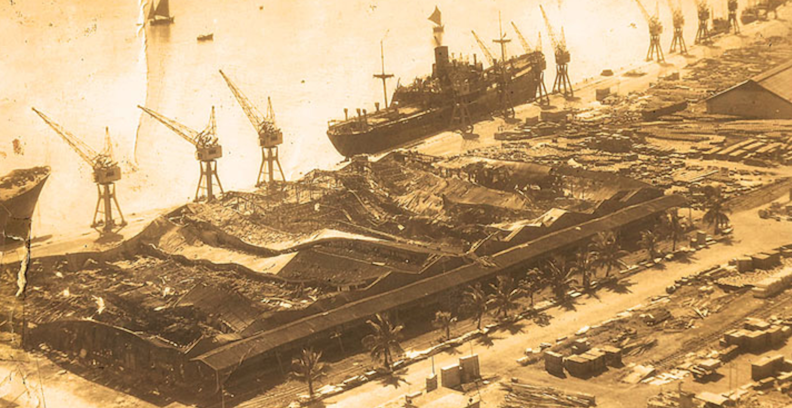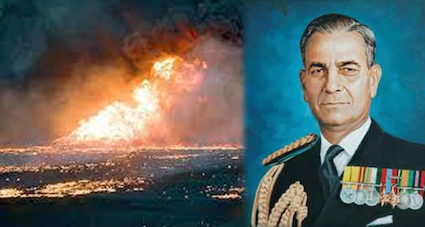(This is the fifth piece in a series on ’71 Indo-Pak War which is celebrating its 50th year this year. The first , second, third and fourth piece could be read by clicking on links).
In December 1971, it was generally accepted in Pakistan Navy that it was no match for the Indian Navy. The people in senior positions in Karachi knew it clearly that if and when Indian Navy launched attack/s, which they feared, there will be massive losses suffered by the Pakistan Navy. Their assessments were based on what we call SWOT (Strength Weaknesses Opportunities Threat) analysis in today’s parlance. Once this analysis had become widely known among the crews manning different naval assets, be it submarines, warships or other sections, gloom was a natural consequence.
The Pakistan naval commanders knew clearly that they were not capable of matching Indian Navy’s superior firepower in terms of launching any offensive actions. More importantly, they also knew that even defending Karachi harbour, which was lifeline of West Pakistan, was not possible for them. So it was with a fairly negative self image that the Pakistan Navy braced itself for action from the Indian Navy.
In 1971, the Indian Army, the Indian Air Force (IAF) and the Indian Navy had all prepared for over seven months, bracing up themselves for the action to begin. They had done rigorous training of their men, tried to fill in gaps in terms of availability of arms and ammunition, and were raring to go. On the other hand, Pakistani Army had started genocidal rapes in East Pakistan, beginning March 25/26, 1971, creating 10 million (1 crore) refugees. The refugees had rushed into India, and left it with no choice but to go to war with Pakistan.
India did not want to play host to over a crore refugees and hoped that once a new country got created in place of East Pakistan, the refugees would go back. How wrong its calculations were as more half the refugees never went back! India’s actions against Pakistan created Bangladesh and East Pakistan was no more. But the genesis of the entire crisis lay in West Pakistan, and blaming India for the creation of Bangladesh is a narrative less than truthful. Unfortunately, a substantial number of Indians also don’t know much about the events that happened 50 years ago.
If only a dispassionate history of Pakistan from December 1970 to December 1971 is written, and widely disseminated, lots of misgivings and wrong narratives can get corrected. Incidentally, the bifurcation of Pakistan, with East Pakistan becoming a separate nation was predicted as early as 1952. Of all the people by a Pakistani Navy officer named S M Ahsan (a Commodore then) in a secret intelligence message sent to ISI headquarters (yes, Inter Services Intelligence).
Ahsan’s signal, Cable 1971, was sent to then ISI chief Major General R Cawthome, talked of the dangers inherent in religious fanaticism and one unit scheme. The cable said that the creation of Committee of Ulemas with powers to veto the decisions taken in the House of People on religious matters gives excessive powers to religious leaders. The Ulemas saying that only a Muslim could be the head of the state also created suspicions among minorities.
The prophesy by Ahsan took almost 20 years to come true! In later years, he rose to become the Commander in Chief of the Pakistan Navy serving under President Ayub Khan from 1966 to 1969. He also remained the Finance Minister of Pakistan for some time under General Yahya Khan when he was made the Governor of East Pakistan in September 1969. He resigned in March 1971 and returned to West Pakistan.
He was responsible for providing fair governance in East Pakistan and conducted the December 7, 1970, elections. Prior to the elections, he predicted that Awami League of Sheikh Mujib Rehman would sweep East Pakistan. Be that as it may. But looking back at past helps.
After the hostilities between India and Pakistan officially broke out on December 3, the Indian Navy went into action within less than 24 hours on December 4, 1971. It launched the first of its attacks on Karachi harbour calling it Operation Trident. It was Surendra Nath Kohli, as Flag Officer In Commanding in Chief of Western Naval Command, under whom the operation was successfully executed. It was an operation that inflicted incalculable damage to Pakistani Navy in Karachi. Not the one to sit back, he launched Operation Python three days later, leading to utter devastation in Karachi.
Op Python was carried out by INS Vinash, a small missile boat, which fired four missiles, all it had in its armoury. Another missile boat INS Vijeta was to accompany it for the second attack on Karachi harbour. However, INS Vijeta developed a technical snag and had to abandon the plans. Even INS Vinash had electric failure on board around 8 pm while going towards Karachi. Its radar stopped functioning and it drifted 7 to 8 miles away from the course it had set itself. This was found by the ship commander at 11 pm when the electricity was restored.
Instead of Karachi harbour, he found himself more in the vicinity of Kemeri oilfields. So, instead of firing only at Karachi as originally planned, he fired first of his missiles at the oilfields. As a result, the entire oil stocks there caught fire and burned for next seven days and nights. INS Vinash was commanded by Commodore Vijay Jerath and he had three missiles left after using the first one. He used all three for lighting up Karachi. Jerath was given a Vir Chakra for carrying out the daring attack.
Kohli became a legend for providing the operational leadership in the attacks and later went on to become the Indian Navy Chief. A post he held for three years. His account of the 1971 war as a memoir is given in a book titled WE DARED. He also authored another book, SEA POWER AND THE INDIAN OCEAN, which analyses geopolitical and maritime concerns of the Indian Ocean region.

Indian Navy had destroyed Karachi Harbour in ’71 War
In Operation Trident, Soviet missile boats sank many ships of the Pakistan Navy, two destroyers named PNS Khaibar and PNS Shah Jahan, besides PNS Muhafiz (a minesweeper ship, appropriately named) in the attacks by missiles. It is said that over 700 Pakistani sailors were either killed or seriously wounded. Besides, the missile attacks also damaged or destroyed many commercial ships. The reserve fuel stocks that had been stored in the harbour were also targeted and many of the tanks caught fire.Indian Navy had destroyed Karachi Harbour in ’71 War
As the Pakistani Navy was trying to recover from the devastation, a follow-up action of Operation Python was carried out. This despite the fact that Pakistan Air Force enhanced its surveillance of skies over Karachi and adjacent sea areas to ward off possible attacks by the Indian Navy. This was carried out on the night of December 8/9 after 11 pm Pakistan Standard Time (PST). In all, four missiles were fired at Pakistan naval targets and all hit home. The total loss suffered in Karachi harbour in Operation Python was estimated to be in the range of $3 billion.
Substantial fuel was destroyed in this attack also, and this affected the operability of both Pakistan Navy and PAF. Overall, this was hugely demoralising for the Pakistan leadership as their economic losses were virtually unbearable. Some civilian ships flying flags of foreign countries also sank in this attack. It virtually led to the Pakistan Navy headquarters becoming dysfunctional.
Sant Kumar Sharma, a seasoned journalist, is an authority on Jammu and Kashmir. Two of his books on Article 370 and Delimitation are already out. The third one on Indus Waters Treaty is now out and could be bought here.
Sant began as a teacher but after six years, joined the Indian Express, Chandigarh in 1990, the year when terrorism was taking its first step in J & K and soon there would be exodus of lakhs of Kashmiri Pandits from the Valley. He subsequently worked for The Statesman, The Times of India and Star News among others. He is based in Jammu since May 2000.
He edits epaper.earthnews.in, a newspaper from Jammu presently.


